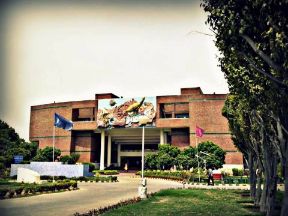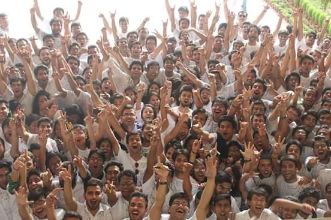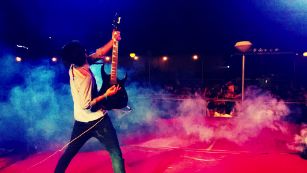
Dr. Pinaki Chakraborty received his B.Tech. from G.G.S. Indraprastha University, and his M.Tech. and Ph.D. from Jawaharlal Nehru University. He joined the faculty of Netaji Subhas University of Technology (then known as Netaji Subhas Institute of Technology) in 2014.
Dr. Chakraborty’s area of interest includes human-computer interaction, educational software, operating systems, compiler construction and computer architecture. He researches and teaches courses on these topics. He follows an experimental approach for research and a hands-on approach for teaching.
Dr. Chakraborty has supervised the dissertation of 3 Ph.D. students and 12 M.Tech. students, and the major project of 172 B.Tech. students. Several of his Ph.D. and M.Tech. students have received awards for the work they did in his supervision.
Dr. Chakraborty is interested in developing products, digital or otherwise, for different human endeavors. He holds two patents.
Dr. Chakraborty is currently executing two funded projects. He also serves as member of the editorial board of three journals of international repute. Dr. Chakraborty is a Fellow of Institution of Electronics and Telecommunication Engineers.
Dr. Chakraborty has used his modest abilities to serve the university in various capacities, viz. result tabulator (2017 - till date), superintendent of practical examination (2018-2022), deputy superintendent of theory examination (2023-2024) and deputy coordinator of M.Tech. admissions (2024).
- Teaching (Click to expand)
-
Dr. Pinaki Chakraborty teaches at both undergraduate and postgraduate levels. His courses attract a large number of students. For example, 104 undergraduate computer science students registered for his course on human-computer interaction in Autumn 2024.
He has developed a mobile app named OSAVA to teach his course on operating systems and a desktop application named PAVT to teach his course on compiler construction. OSAVA visualizes various algorithms used in operating systems, while PAVT visualizes different parsing algorithms. His course on human-computer interaction includes mini-projects on typeface designing, interface designing and usability testing, which students find very engaging. He conducts interesting experiments and shares the findings in the classroom. Occasionally, he holds tutorial classes in the lawn.

OSAVA 
OSAVA in use in the online lectures during the pandemic 
PAVT 
Typeface designing 
Experimenting with virtual reality 
Experimenting with virtual reality haptic jacket 
Experimenting with brain-computer interface in Dr. D.V. Gadre's lab 
Outdoor tutorial class
- Sample Journal Publications (Click to expand)
-
Human-computer interaction
- Sakshi, Bhatia, M. P. S. and Chakraborty, P. 2024. Meta-heuristic based feature selection for aberration prediction in human activity using smartphone inertial sensors. International Journal of Information Technology, 16(1): 559-568.
- Sakshi, Bhatia, M. P. S. and Chakraborty, P. 2024. Detection of aberration in human behaviour using shallow neural network over smartphone inertial sensors data. Computational Intelligence, 40(5): article e12699.
- Arora, A., Chakraborty P., Bhatia, M. P. S., Kumar, A. 2024. Deep-SQA: A deep learning model using motor activity data for objective sleep quality assessment assisting digital wellness in healthcare 5.0. Expert Systems, 41(7): e13321.
- Chakraborty, P. and Yadav, S. 2023. Human-computer interaction: An everyman’s introduction. Everyman’s Science, 56(5-6): article 2.
- Chakraborty, P. and Yadav, S. 2023. Applicability of Fitts’ law to interaction with touchscreen: Review of experimental results. Theoretical Issues in Ergonomics Science, 24(5): 532-546.
- Yadav, S., Chakraborty, P. and Mittal, P. 2022. Designing drawing apps for children: Artistic and technological factors. International Journal of Human–Computer Interaction, 38(2): 103-117.
- Yadav, S., Chakraborty, P. and Mittal, P. 2022. A mathematical model for suitability of smartphone apps for children. Human Behavior and Emerging Technologies, 2022: article 3493218.
- Yadav, S. and Chakraborty, P. 2022. Child-smartphone interaction: Relevance and positive and negative implications. Universal Access in the Information Society, 21(3): 573-586.
- Yadav, S. and Chakraborty, P. 2022. Children’s ability to engage in video chatting: Expressiveness, recall and problem solving. Journal of Human Behavior in the Social Environment, 32(8): 1070-1088.
- Arora, A., Chakraborty, P. and Bhatia, M. P. S. 2022. Intervention of wearables and smartphones in real time monitoring of sleep and behavioral health: An assessment using adaptive neuro fuzzy technique. Arabian Journal for Science and Engineering, 47(2): 1999-2024.
- Yadav, S., Chakraborty, P., Meena, L., Yadav, D. and Mittal, P. 2021. Children’s interaction with touchscreen devices: Performance and validity of Fitts’ law. Human Behavior and Emerging Technologies, 3(5): 1132-1140.
- Arora, A., Chakraborty, P., Bhatia, M. P. S. and Mittal, P. 2021. Role of emotion in addictive use of Twitter during COVID-19 imposed lockdown in India. Journal of Technology in Behavioral Science, 6(2): 370-377.
- Yadav, S., Chakraborty, P., Kochar, G. and Ansari, D. 2020. Interaction of children with an augmented reality smartphone app. International Journal of Information Technology, 12(3): 711-716.
- Yadav, S., Chakraborty, P., Kaul, A., Pooja, Gupta, B. and Garg, A. 2020. Ability of children to perform touchscreen gestures and follow prompting techniques when using mobile apps. Clinical and Experimental Pediatrics, 63(6): 232-236.
- Arora, A., Chakraborty, P. and Bhatia, M. P. S. 2020. Analysis of data from wearable sensors for sleep quality estimation and prediction using deep learning. Arabian Journal for Science and Engineering, 45(12): 10793-10812.
- Arora, A. and Chakraborty, P. 2020. Diagnosis, prevalence and effects of nomophobia – A review. Psychiatry Research, 288: article 112975.
- Yadav, S., Chakraborty, P., Mittal, P. and Arora, U. 2018. Children aged 6-24 months like to watch YouTube videos but could not learn anything from them. Acta Paediatrica, 107(8): 1461-1466.
- Yadav, S. and Chakraborty, P. 2017. Children aged two to four are able to scribble and draw with a smartphone. Acta Paediatrica, 106(6): 991-994.
Educational software
- Yadav, S. and Chakraborty, P. 2024. Reinforcing biology education in schools using smartphones: A post-COVID pandemic study. Education and Information Technologies, 29(3): 3615-3635.
- Yadav, S. and Chakraborty, P. 2023. Introducing schoolchildren to computational thinking using smartphone apps: A way to encourage enrollment in engineering education. Computer Applications in Engineering Education, 31(4): 831-849.
- Yadav, S. and Chakraborty, P. 2023. Ability of four to six year old children to learn novel words from digital media. Clinical Pediatrics, 62(9): 965-968.
- Kanika, Chakraverty, S., Chakraborty, P., and Madan, M. 2023. Effect of different grouping arrangements on students’ achievement and experience in collaborative learning environment. Interactive Learning Environments, 31(10): 6366-6378.
- Yadav, S., Chakraborty, P., Meena, L. and Yadav, D. 2022. Children’s ability to read from computers and smartphones. Journal of Educational Technology Systems, 50(4): 521-539.
- Yadav, S. and Chakraborty, P. 2022. Using Google voice search to support informal learning in four to ten year old children. Education and Information Technologies, 27(3): 4347-4363.
- Jovanovic, N., Stamenkovic, S., Miljkovic, D. and Chakraborty, P. 2022. ComVIS – Interactive simulation environment for compiler learning. Computer Applications in Engineering Education, 30(1): 275-291.
- Kanika, Chakraverty, S., Chakraborty, P., Madan, M., Gupta, G. and Aggarwal, A. 2021. VISTA: A teaching aid to enhance contextual teaching. Computer Applications in Engineering Education, 29(6): 1526-1541.
- Jovanovic, N., Miljkovic, D., Stamenkovic, S., Jovanovic, Z. and Chakraborty, P. 2021. Teaching concepts related to finite automata using ComVis. Computer Applications in Engineering Education, 29(5): 994-1006.
- Chatterjee, I. and Chakraborty, P. 2021. Use of ICT by medical educators amid COVID-19 pandemic and beyond. Journal of Educational Technology Systems, 49(3): 310-324.
- Chakraborty, P., Mittal, P., Gupta, M. S., Yadav, S. and Arora, A. 2021. Opinion of students on online education during the COVID-19 pandemic. Human Behavior and Emerging Technologies, 3(3): 357-365.
- Stamenkovic, S., Jovanovic, N. and Chakraborty, P. 2020. Evaluation of simulation systems suitable for teaching courses on compiler construction. Computer Applications in Engineering Education, 28(3): 606-625.
- Rodriguez-Sanchez, M. C., Chakraborty, P. and Malpica, N. 2020. International collaborative projects on digital electronic systems using open source tools. Computer Applications in Engineering Education, 28(4): 792-802.
- Kanika, Chakraverty, S., Chakraborty, P. and Khapra, S. 2020. A genetic algorithm based approach for making pairs and assigning exercises in a programming course. Computer Applications in Engineering Education, 28(6): 1708-1721.
- Kanika, Chakraverty, S. and Chakraborty, P. 2020. Tools and techniques for teaching computer programming: A review. Journal of Educational Technology Systems, 49(2): 170-198.
- Singh, T., Afreen, S., Chakraborty, P., Raj, R., Yadav, S. and Jain, D. 2019. Automata simulator: A mobile app to teach theory of computation. Computer Applications in Engineering Education, 27(5): 1064-1072.
- Chakraborty, P., Arora, U., Mukhija, N., Goel, V., Priyanka, Shikhar, S. and Takhar, R. 2019. OSAVA: An Android app for teaching a course on operating systems. Journal of Engineering Education Transformations, 32(4): 20-30.
- Agarwal, C. and Chakraborty, P. 2019. A review of tools and techniques for computer aided pronunciation training (CAPT) in English. Education and Information Technologies, 24(6): 3731-3743.
- Sangal, S., Kataria, S., Tyagi, T., Gupta, N., Kirtani, Y., Agrawal, S. and Chakraborty, P. 2018. PAVT: A tool to visualize and teach parsing algorithms. Education and Information Technologies, 23(6): 2737-2764.
- Jain, D., Patil, A. P., Nawal, D. J. and Chakraborty, P. 2018. ARWAK: An augmented reality wordbook smartphone app for kindergarteners. Journal of Multi Disciplinary Engineering Technologies, 12(2): 59-66.
- Jain, A., Goyal, A. and Chakraborty, P. 2017. PPVT: A tool to visualize predictive parsing. ACM Inroads, 8(1): 43-47.
- Joseph, D., Kaur, G. and Chakraborty, P. 2016. An exercise on hardware/software codesign following the RISC model. Computer Applications in Engineering Education, 24(2): 305-312.
- Chakraborty, P., Saxena, P. C. and Katti, C. P. 2013. A compiler-based toolkit to teach and learn finite automata. Computer Applications in Engineering Education, 21(3): 467-474.
- Chakraborty, P., Saxena, P. C. and Katti, C. P. 2012. Automata simulators: Classic tools for computer science education. British Journal of Educational Technology, 43(1): E11-E13.
- Chakraborty, P., Saxena, P. C. and Katti, C. P. 2011. Fifty years of automata simulation: A review. ACM Inroads, 2(4): 59-70.
- Chakraborty, P. 2007. A language for easy and efficient modeling of Turing machines. Progress in Natural Science, 17(7): 867-871.
Compiler construction
- Chakraborty, P. 2015. Fifty years of peephole optimization. Current Science, 108(12): 2186-2190.
- Gupta, T., Yadav, S. and Chakraborty, P. 2017. Compiler bootstrapping and cross-compilation. Current Science, 112(5): 906-907.
Note: Please see Google Scholar profile for more publications.
- Sample Conference Publications (Click to expand)
-
- *Agarwal, C., Sharma, S. and Chakraborty, P. 2024. VAE MDD: VAE-based multi-modal analysis for enhanced mispronunciation recognition. Second International Conference on Artificial Intelligence and Applications (New Delhi). [Best Paper Award
- *Sakshi, Bhatia, M. P. S. and Chakraborty, P. 2023. Fall detection of elderly in ambient assisted smart living using CNN based ensemble approach. International Conference on E-Business Technologies (Belgrade, Serbia). [Best Paper Award]
- Rajwal, S. and *Chakraborty, P. 2023. Application of artificial intelligence in compiler design. Forty-first National Conference on Recent Trends in 5G Technology & Artificial Intelligence (Delhi). [Best Paper Award]
- *Yadav, S., Chakraborty, P. and Yadav, S. 2022. A model for teaching geometry to schoolchildren using smartphone app. International Conference on Electrical, Electronics, Information and Communication Technologies (Tiruchirappalli). [Best Paper Award]
- *Yadav, S., Chakraborty, P., Jain, K. and Jyotirmaya. 2021. A user centered design approach to develop a mobile app for children. International Conference on Computational Performance Evaluation (Shillong). [Best Paper Award]
- *Chakraborty, P. 2007. An assortment of methods for mining dense substructures in a large graph. National Conference on Information Technology: Present Practices and Challenges (New Delhi). [Best Paper Award]
* Presenting author.
- Patents (Click to expand)
-
- Chakraborty, P. Computer Keyboard with an Integrated Touchpad. Indian patent, Patent no.: 479715.
- Sharma, J. G., Chakrabarti, R. and Chakraborty, P. A Reusable Digestion Tube for Amino Acid Assay. Indian patent, Patent no.: 551061.



